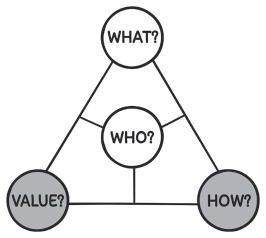Orchestrator
Directing the value chain

The pattern
Orchestrator companies focus on their core competencies. Any activities in the value chain that fall outside these areas are outsourced to specialised service providers who possess the necessary skills to carry them out successfully (HOW?). Thus, as director of the value chain, the Orchestrator will spend a great deal of time coordinating and matching individual value creation activities. The comparatively higher transaction costs that this incurs are offset by taking advantage of partners’ specific skills (VALUE?). An important advantage of the Orchestrator pattern is that it gives rise to close cooperation with external partners, whose innovative capacity can benefit one’s own production (HOW?, VALUE?).

The origins
The Orchestrator pattern traces back to the 1970s, when growing globalisation and resulting cost pressures forced more and more companies to outsource parts of their value chains to countries with lower production and labour costs. The primary beneficiaries of this first wave of outsourcing – the Asian Tigers with their export-oriented industrialisation strategies – were the perfect foil to Western companies’ outsourcing goals. One of the pioneers of the Orchestrator pattern was the fashion industry, which began to move large segments of its production to Asia early on.
A prominent example of the application of this business model is offered by sports equipment manufacturer Nike. In the early 1970s, under CEO Phil Knight’s stewardship, Nike started to outsource production of its products to low-wage countries such as Indonesia, China, Thailand and Vietnam, and to concentrate more on its own core competencies of R&D, product design and marketing. Cost savings from outsourcing and this new focus gave Nike an advantage over its competitors, establishing the company at the head of the sports equipment industry. Nike still produces an estimated 98 per cent of its products in Asia today, making the Orchestrator pattern an integral part of its business model.
The innovators
Several companies have used the Orchestrator pattern successfully for business model innovations in the past. Among them is Indian telecommunications services company Airtel, which was founded in 1995. With over 260 million customers, it has evolved to become one of the largest telecommunications companies in the world. Airtel possessed very little to differentiate it from other telecommunications providers. It began to turn itself into an Orchestrator from 2002 onwards, laying emphasis on its core competencies of marketing, sales and finance, and outsourcing other parts of its value chain such as IT support to companies such as Ericsson, Nokia, Siemens and IBM. Airtel negotiated contracts with these companies that allowed it to incur only variable costs on the basis of capacity used. Trimming the value chain in this way made it possible for the company to offer its telecommunications services at very low rates. Its Orchestrator role increased Airtel’s revenues by up to 120 per cent, and its annual net profits by some 280 per cent, between 2003 and 2010.
China’s Li & Fung is also a profitable Orchestrator. It accepts production and development orders from prominent customers such as Abercrombie & Fitch or Walmart for a variety of goods ranging from toys to fashion accessories to apparel. Li & Fung does not produce these goods itself but manages a global network of more than 10,000 suppliers who complete the tasks. As such, the company is a global supply chain Orchestrator, with the core competence of connecting individual value chain partners and processes. Without owning a single factory, Li & Fung earns multi-billion-dollar revenues every year.
The food company Richelieu produces frozen pizzas, salad dressings, sauces, marinades, condiments and deli salads, which are then marketed by other companies as their in-store or White Label brand (#55). Thereby, Richelieu is able to focus on the manufacturing stage of the food products, and is not concerned with marketing, branding, etc. As a consequence, Richelieu generated approximately US $325 million revenues in 2016, with nearly 900 employees – around US $360,000 per worker.
When and how to apply Orchestrator
To be an Orchestrator you need to know and fully understand your company’s key strengths. This is especially true if you are active in a large number of steps in your value chain. As an Orchestrator you focus all your efforts on those activities you know you excel at and outsource the rest, thereby reducing costs and increasing flexibility. It is paramount that you hold your cards close, otherwise you risk being replaced by another company. In order to be a good Orchestrator, you need to be good at actively managing diverse partners.
Some questions to ask
- What are our key activities?
- Where do our unique strengths lie?
- Which activities are less important for our value proposition as a whole? Could we outsource them to other firms?
- Will we be able to reduce our total costs by outsourcing certain activities?
- How can we become more flexible?
- Are we capable of managing different partners at the same time?

